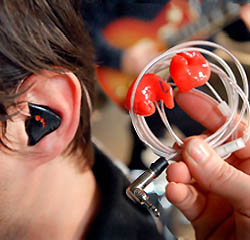1) Both Ears Or None. Using only one ear encourages much higher sound levels. Good custom molds provide 20 to 25 dB of isolation, allowing lower monitoring levels for artists, and reduced stage noise to compete with front of house. Mixed mode monitoring combining wedges and personal monitors ultimately results in higher overall SPL.
2) Hard-Wired Equals Hi-Def. Wired personal monitors will always sound better than wireless. In addition to loss of stereo separation and frequency response, multiplexed stereo wireless transmissions are susceptible to noise and multipath distortion.
Panned wireless mixes must be extreme as 7 o’clock and 5 o’clock pan positions become 9 a.m. and 3 p.m. due to reduced separation, and response falls off above 15,000 Hz for most wireless personal monitor systems.
3) Use A Helical Antenna. Wireless personal monitors are inherently non-diversity RF systems, where the benefits of a helical antenna’s directivity and full-angle 360 degree RF modulation can eliminate dropouts that affect multiplexed stereo transmissions more than mono.
4) Custom-Fitting Molds. Generic-fit transducers rely on replaceable foam or triple-flanged “Christmas tree” fittings to seal the ear and block out other sound. Most generic devices can also be fitted with custom molded sleeves, made of soft silicone from audiologist impressions, at half the cost of custom molds.
5) Stereo Is Better. A realistic mix, with performers on the stage’s far side panned to that ear, makes it easier to listen. Panning inputs in a stereo mix allows similar sounding instruments to stand out at lower volumes. Reverb naturally sounds better in stereo. Singers can harmonize better when their voice is centered and others are panned.
6) Drum Sub. The impact shakers and subwoofers add often helps drummers perform at their best. Other band members may decide this is something they also want, but there’s a diminishing return in adding subs, as it doesn’t help other musicians as much and it quickly begins polluting the stage with excessive low end. When drummer and bass player are in close proximity, they naturally share the drum sub.
















